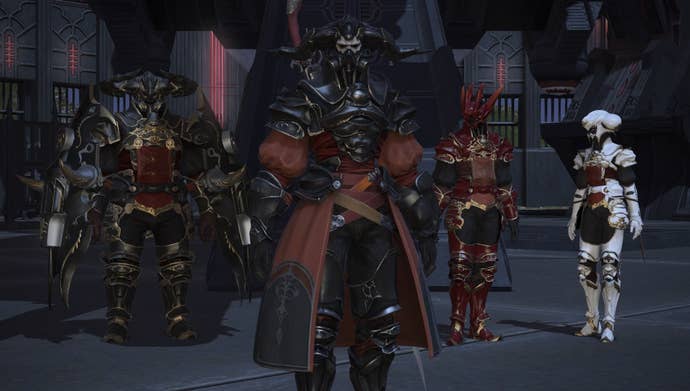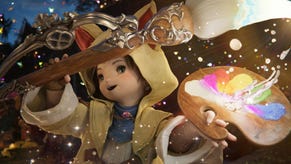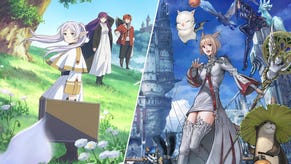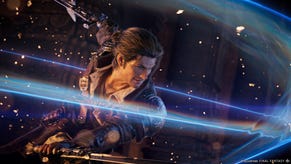Final Fantasy XIV’s Yoshida: PVP Creates a “Real, Living Economy”
In a post-launch interview, Mike talks with Naoki Yoshida about PVP, evolving Final Fantasy design, and bringing the East and West together.
This article first appeared on USgamer, a partner publication of VG247. Some content, such as this article, has been migrated to VG247 for posterity after USgamer's closure - but it has not been edited or further vetted by the VG247 team.
So Final Fantasy XIV: A Realm Reborn is out. It's live and it's good! (Have you read our review yet?) Square Enix rebuilt a broken game into something worth playing and at the center of that effort is game director and producer Naoki Yoshida. Yoshida's love for Final Fantasy and MMOs as a whole comes through in the current game.
The game has had some trials and tribulations since the early access period, but Square Enix has been working hard to address those issues. In other interviews and posts, Yoshida has apologized to the community and promised to fix the problems. Yesterday, there was a major maintenance effort to alleviate the service issues. While those issues aren't 100 percent gone, the state of the game is much better than at launch.

But before I could ask any questions, Yoshida did want to address you, the fans, directly.
"So, over these past three years when talking to the media and the fans, we've always put an emphasis on the three pillars that we're building our game upon," Yoshida began. "That is having the best graphics in the industry, having the best game experience, and having the best storyline that fans of the Final Fantasy series have come to expect. And on top of those three pillars, having that community to bring it all together."
"We have a great community that stuck with us since the original launch and now with the launch of A Realm Reborn we have new players that have combined together with that great foundation to create this new community that will sit upon those three pillars. That will create the foundation for this great game that we will continue expanding upon and creating with the players for the next five or ten years to come."
"Because of the trouble that we had three years ago with that original launch, we kept our expectations low for this launch," he continued. "We thought that the start would be a little bit slower. We thought that a lot of players would be wary; they would wait to see what their friends had to say before getting into the game. Because the Western market and Western fans had kept such an open mind over these two and a half years, when the game was launched they didn't wait for their friends. They trusted us. They went and bought the game and that created the congestion at the beginning."
And again Yoshida apologized. To you. The issues weren't acceptable, but he and his team are doing what they can to make it right. So this interview isn't about those problems. They've been talked about before, all questions have been asked and answered. All that's left is to wait and see if Square Enix makes good on its promises. With that said, let's get to the real meat.
Because every single Final Fantasy is a different type of game - it's in a different world, has different characters - everyone has a different image of what Final Fantasy is.
USgamer: Previously you said that Square Enix's problem with Final Fantasy XIV during the first launch is that they just put the "Final Fantasy" name on it and expected it to sell. What does Final Fantasy mean to you?
Naoki Yoshida: As you know, the Final Fantasy franchise is in its 26th year, it has a long, long history. This is the 14th numbered game in that series. Because every single Final Fantasy is a different type of game - it's in a different world, has different characters - everyone has a different image of what Final Fantasy is. Your image of what Final Fantasy is different from what my image of Final Fantasy is. For some people, it's chocobos. For some, it's moogles. For some people, it's the job system. Active Time Battles. For those who love Final Fantasy VII, it might be the Limit Breaks.

So, when creating Final Fantasy XIV, one of the biggest themes and one of the things that I wanted to do the most was have a game where the player gets to be the hero. Have that straight story where the player is the hero; the player follows the crystal's call and then goes and saves the world and becomes the Warrior of Light. Not do it in some kind of light manga-type story, but have a deep, dark, and rich story. And within this story, bring in those facets of the Final Fantasy world that everyone has come to love. Bring in the chocobos and the moogles. But not just bring them in and have them there, make them part of the story. Give them their own stories.
By doing this, you have this deep story, but you have parts from all different Final Fantasy's. Something that everyone is going to look into and find something that they feel is a Final Fantasy game. We've been getting a lot of feedback from our players in this past week, saying that, 'yes, Final Fantasy is finally back. This game really feels like a Final Fantasy.' So we think that we've been somewhat successful in providing that type of experience.
So from even the smaller portions of the game's design, things like background music or even deciding what is going to be the first battle with a summon. We wanted it to be Ifrit, because everyone knows Ifrit. And we didn't want to to be some kind of wimpy battle - Ifrit is a staple of the series - so, we wanted you to meet a wall, have it be a real challenge for the players. So, in game design, we've made sure that we've covered all of the bases and tried to make a real Final Fantasy experience.
USG: With that big focus on story, the game seems mostly complete. Do you really need PVP in FFXIV?
NY: This is decision that gets really deep into the basic design of an MMORPG. In most MMORPGs, you have crafters and gatherers that support and build the economy of an MMO. The gatherers will gather the material and the crafters will take the materials and they're craft things. But to make sure that gatherer and crafters have things to create, you need content that uses these things. You need to create a demand for those items. By having more content, like PVP, then it will use these items.
In a game like this, we don't expect every player to play PVP. We actually think it's going to be around 15 to 20 percent of the userbase. These players, when they really get into PVP, are going to need different types of items and armor than they will need in PVE. For example, when you're fighting a single monster and that monster casts Sleep on you, you won't really need an armor that might cut that Sleep in half, because it's a one-on-one thing and you can wait that 30 seconds. But in a PVP-type of battle you're not going to want to stand there for 30 seconds because that could be the end of you. So, you're going to need a different type of armor, armor that will cut that Sleep versus fighting a regular monster. You're going to need all of these specialty items that won't really help a lot in PVE, but will help in PVP. By creating this new set of items that are only for PVP, it's creating more work for those crafters and gatherers.

And of course, we have other items like potions and food. These things are going to be used a lot more in PVP than they will be in PVE. On top of that, you have things like the housing system, things that players don't have to play; if they want to concentrate on PVE that's fine. If they don't want to concentrate on PVP, that's fine. Maybe they just want to focus on housing. You have all of those different aspects of games beyond just one single one that you can build the economy off of. Crafters will be able to create for not just one of these areas, but for all three areas. That will create a real, living economy and support those players and what they want to do in the game.
Because this game, while it is a Final Fantasy game, it is also an MMORPG. We have to recognize what things are necessary for an MMORPG. I personally like PVP and want to have that in the game.
USG: With the job system, I find that players tend to have a single character instead of switching between a number of alts. Do you feel that's a good or bad thing for the game's overall lifespan?
NY: I've played MMOs for over 20 years and I've become a very hardcore player myself. I remember there were times where I'd be playing a game and my normal character was ranged DPS. Our party wanted to go somewhere and we didn't have a healer. That means I'd have to log off, get on my other character, which means I'd have to have a healer character ready and leveled with all of the best gear, which means I would've had to spend time to do that as well. Because I was a hardcore gamer, I didn't mind leveling all those extra characters and getting all of that extra gear. I had the time. I also received some accounts from friends that had quit.
When you look at today's players and the more casual player, if one person just has one character and you want to go on a raid, they say, 'we need a healer.' But you don't have a healer, and it leaves no options for a lot of people. There's no healer today, so they can't play. We didn't want to create that. We wanted to create something that would allow all players to have the game fit their lifestyle. Having this armory system which allows players to play all different classes as the same character, while also giving incentives to raise other classes.
That one character, because you've stuck with it so much, it comes your alter ego. It becomes you. You have a lot of feelings for that character, rather than switching between a lot of different characters. You love that person that you've been. We believe this expands horizons and opens a lot of doors for players that might not have been able to experience most of the game if they were forced to play with a bunch of different characters.
We wanted to create something that would allow all players to have the game fit their lifestyle.
A lot of people ask, 'when are you going to raise the level cap' and I reply, 'do you really want to level this much? Is leveling that fun?' Rather than leveling that one character, why don't you just switch to a different job and try something new? There's 50 more levels with that other class!
USG: Do you find in watching the players that they'll stick with classes within the role they prefer? For example, I love tanking, so I'm a gladiator now and I will probably try marauder, but something like dragoon holds little interest for me.
NY: Currently, what we're seeing is that because so many people want to see what happens next in the story - we designed the story so that its all connected, you finish one quest and that next quest is available - they pretty much stick with one job and are focusing on just doing the story. We see about 60 percent of the players doing this. When they get to 30 and they want to get their job, they get another class up to 15, but then they'll go back to that main one and continue the story. For the first 60 percent, that's what we're seeing.
The remaining 40 percent, we see that they try out this job, then they realizing that they can do crafting. They'll play a crafter for awhile, and then they'll see someone with the Carbuncle and decide, 'I want a Carbuncle,' so they'll try that. They'll try all of the jobs. We have 40 percent of the people with pretty much every job around level 15 or 18.
That 60/40 percent split, a lot of it is that 40 percent are the people that are playing an MMO for the first time. They don't know what an MMO encompasses. They want to try out everything and see what fits them the best. Those veterans that know MMOs, they're going to want to experience that one job and get that one job to the top level. That's the kind of player they are.
The people that are new to the game are actually experiencing a lot more of the game. They don't have anything holding them down. These rules that say, 'I got to level this one job, because I have to see the end of the game.' They take it easy.
USG: The higher-level gear is very Final Fantasy in feel. Dragoons look like Kain Highwind from Final Fantasy IV for example. How do you carry that idea forward as you start raising the level cap?
NY: I'd like to thank you. When you say that it feels like real Final Fantasy armor and it enhances that job, that's exactly what we're aiming for when we designed those. We do have more in store. I can't tell you much, but we're currently designing and developing the next set of artifact armor, which will expand on those designs. It's going to be even greater than what we have now. It will feature a lot of the designs based on the original work from Mr. Amano. We can't tell you anymore, but that armor will be released very soon. It's really, really cool.

USG: Do you feel that's a chance for you to define what these jobs are in Final Fantasy as a whole? Do you get to carve out a new path for what a Dragoon or Black Mage looks like?
NY: That's a good question because we try to change a little bit and try something new with each design. However the art team can get a little nervous when having to change something. They ask, 'How far can we go?' They understand that the fans expect certain things, but they want to try things themselves. What we've decided is that for PVP armor, we allow them to use their whole creativity and do things that are really original. When it comes to PVE, we want them to respect what came before. So you have that basic silhouette that a staple of the Final Fantasy series and then we build off of that. Maybe keep that silhouette, but at something that's little bit Final Fantasy XIV to that while maintaining the original. Adding to that and seeing how the players react to that change. If the response is good, then may change it a little more for the next set of armor. Keeping the new and original along with the traditional.
USG: Final Fantasy XIV is a synthesis of Japanese and Western game design. Do you view East and West as different set of players, or as one global playerbase?
What we've decided is that for PVP armor, we allow them to use their whole creativity and do things that are really original. When it comes to PVE, we want them to respect what came before.
NY: We're going to back to the RPG genre in Japan in general. You look back to Dragon Quest, which brought the RPG genre to Japan. But you look back at the developers of Dragon Quest and what were they inspired by? They were fans of Ultima and Wizardry. They played those games and thought, how can we bring this to Japan? A lot of developers later started playing Everquest. They thought, how can we bring this to Japan? Final Fantasy XI was the answer to that question. A lot of games in Japan are influenced by those Western games.
When designing this game, it's creating something that I'd enjoy and putting that in a package that accessible to people all around the world. That has been my major goal. We've learned so much, because most of the great MMOs in the world are from the West. Especially when it comes to game mechanics and UI. So, we had to bring a lot of that into Final Fantasy XIV. A lot of Japanese players who had never played a Western MMO are getting to play this now and are saying, 'wow, this is really different from what we've played before. This is actually a lot of fun!' So a number of Japanese players are finally being introduced to this MMO game experience.
On the other hand, Western players are playing FFXIV and experiencing this great story. For a lot of Western MMO players, story is non-existent in a lot of MMOs. When you see a story that's this deep and great; having these great battle interact with these stories. That's something the Western players find really exciting. Basically, we've taken the best of both worlds, put it together, and created something for everyone in the world to enjoy.
That's because I love all games, whether they're from the West or Japan. I wanted to bring those ideas together.









